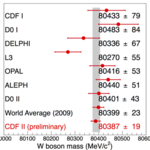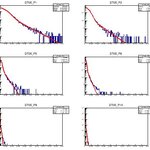Physics

In a recent post I discussed how even the simplest kind of data display graph - the histogram - can sometimes confuse and be misinterpreted. Which is a total howler, as graphs are supposedly means of clarification and immediate, at-a-glance, interpretation of data summaries.In this second part of the article, I wish to consider a few other kinds of histograms, which instead of reporting relative frequencies are used to report the value of a quantity of interest (usually on the vertical axis, although exceptions abound) as a function of a variable which may be continuous, integer, or…

The discovery of a new exotic hadron, named T_cc+, was announced by the LHCb Collaboration a little over a week ago. Unlike some previous discoveries of other resonances by the LHC experiments (dozens have been announced since 2010 by LHCb, and to a lesser extent by CMS and ATLAS) the one of the T_cc+ is is very significant and exciting, and it promises to advance our understanding of low-energy QCD, with repercussions across the board.
In this article I will try to explain what makes it significant. For that, I will be leveraging explanations and input from my dear friend Marek…

Time and again, I get surprised by observing how scientific graphs meant to provide summarized, easy-to-access information get misunderstood, misinterpreted, or plainly ignored by otherwise well-read (mis-)users. It really aches me to see how what should be the bridge over the knowledge gap between scientists and the general public becomes yet another hurdle. Regulars of this blog do not belong to the category of people who needs to be educated on the matter of how to read a graph. So, why should I try to distribute here any sort of user manual, given that I would certainly be doing an…

When subnuclear particles traverse matter they give rise to a multitude of physical phenomena. The richness of the different processes is a crucial asset for the construction of sensitive particle detectors, and it is interesting in its own right. Indeed, it has been a very vigorously pursued field of research of its own ever since the end of the nineteenth century, with the discovery of X rays(produced when electrons released their kinetic energy as they reached the cathode of an accelerating tube), and then after Rutherford's team bombarded gold foils with alpha particles (helium nuclei)…

The virtual conference "From Quarks to Cosmos with AI", organized by Carnegie-Mellon University and which took place last week, included a set of problems in particle and astroparticle physics that participants were invited to tackle with machine learning tools, during four 2-hour afternoon sessions.I took part to the conference by lecturing about applications of differentiable programming to fundamental physics, as well as by organizing (with my collaborators Giles Strong and Lukas Layer) a data challenge centered on a tough regression problem.
The problem in question The virtual…

Following my strong belief that science dissemination, and open borders science, is too important to pursue as a goal to constrain it by fears of being stripped of good ideas and scooped by fast competitors, I am offering here some ideas on a reserch plan I am going to follow in the coming months.
The benefits of sharing thoughts early on is evident: you may, by reading about them below, be struck with a good idea which may further improve my plan, and decide to share it with me; you might become a collaborator - which would add to the personpower devoted to the research. You might point out…

After over one year of forced confinement, due to the still ongoing Covid-19 pandemic, academics around the world seem to have settled down on the idea that after all, we can still do our job via videoconferencing. We had to adapt to the situation as everybody else, of course, and in a general sense we are a privileged minority - other human occupations which are only possible in person suffered way more.
International conferences are one of the things that could most quickly be reconfigured. In the past, presentations by video conference were a last resort, and one used very rarely and only…

Through two observations that match theoretical expectations for a Black Hole neutron star merger humanity can now place limits on how often these occur. About once per month within a one billion light year radius of the Earth Black Holes and Neutron Stars merge. We do not seem to see any from any from inside our own galaxy. If we did the signals would be stronger. This is not the first time we may have observed such an event but there was much more question of just what it was. In any case, as I showed for public consumption with a simple calculation the result…

One of the reasons why I love my job as a researcher in experimental physics is that every day brings along a new problem to solve, and through decades of practice I have become quick at solving them, so I typically enjoy doing it. And it does not matter whether the problem at hand is an entirely new, challenging one or a textbook thing that has been solved a million times before. It is your problem, and it deserves your attention and dedication.The other day I had a collaborative coding session with a post-doc (who also has a blog here, where he writes interesting stuff on machine learning…

Anyone writing that Einstein was fundamentally wrong has not understood General Relativity. There are really two different things which are General Relativity. There are the principles that define General Relativity in particular the Einstein Equivalence Principle. Then there are mathematical realizations of those principles like the Einstein Hilbert Action, from which we derive predictions from the big bang, to light bending due to the Sun, to Black Holes, and gravitational waves. So if you see a headline saying Einstein was wrong the answer is no. His theories…